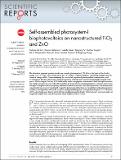| dc.contributor.author | Mershin, Andreas | |
| dc.contributor.author | Matsumoto, Kazuya | |
| dc.contributor.author | Kaiser, Liselotte | |
| dc.contributor.author | Yu, Daoyong | |
| dc.contributor.author | Vaughn, Michael | |
| dc.contributor.author | Nazeeruddin, Md. K. | |
| dc.contributor.author | Bruce, Barry D. | |
| dc.contributor.author | Graetzel, Michael | |
| dc.contributor.author | Zhang, Shuguang | |
| dc.date.accessioned | 2015-06-16T17:50:27Z | |
| dc.date.available | 2015-06-16T17:50:27Z | |
| dc.date.issued | 2012-02 | |
| dc.date.submitted | 2011-08 | |
| dc.identifier.issn | 2045-2322 | |
| dc.identifier.uri | http://hdl.handle.net/1721.1/97441 | |
| dc.description.abstract | The abundant pigment-protein membrane complex photosystem-I (PS-I) is at the heart of the Earth’s energy cycle. It is the central molecule in the “Z-scheme” of photosynthesis, converting sunlight into the chemical energy of life. Commandeering this intricately organized photosynthetic nanocircuitry and re-wiring it to produce electricity carries the promise of inexpensive and environmentally friendly solar power. We here report that dry PS-I stabilized by surfactant peptides functioned as both the light-harvester and charge separator in solar cells self-assembled on nanostructured semiconductors. Contrary to previous attempts at biophotovoltaics requiring elaborate surface chemistries, thin film deposition, and illumination concentrated into narrow wavelength ranges the devices described here are straightforward and inexpensive to fabricate and perform well under standard sunlight yielding open circuit photovoltage of 0.5 V, fill factor of 71%, electrical power density of 81 µW/cm[superscript 2] and photocurrent density of 362 µA/cm[superscript 2], over four orders of magnitude higher than any photosystem-based biophotovoltaic to date. | en_US |
| dc.description.sponsorship | Intel Corporation | en_US |
| dc.description.sponsorship | Knut and Alice Wallenberg Foundation (Fellowship) | en_US |
| dc.description.sponsorship | John Simon Guggenheim Memorial Foundation (Guggenheim Fellowship) | en_US |
| dc.description.sponsorship | National Science Foundation (U.S.). Nanoscale Interdisciplinary Research Team | en_US |
| dc.language.iso | en_US | |
| dc.publisher | Nature Publishing Group | en_US |
| dc.relation.isversionof | http://dx.doi.org/10.1038/srep00234 | en_US |
| dc.rights | Creative Commons Attribution | en_US |
| dc.rights.uri | http://creativecommons.org/licenses/by-nc-sa/3.0/ | en_US |
| dc.source | Nature Publishing Group | en_US |
| dc.title | Self-assembled photosystem-I biophotovoltaics on nanostructured TiO[subscript 2] and ZnO | en_US |
| dc.type | Article | en_US |
| dc.identifier.citation | Mershin, Andreas, Kazuya Matsumoto, Liselotte Kaiser, Daoyong Yu, Michael Vaughn, Md. K. Nazeeruddin, Barry D. Bruce, Michael Graetzel, and Shuguang Zhang. “Self-Assembled Photosystem-I Biophotovoltaics on Nanostructured TiO[subscript 2] and ZnO.” Sci. Rep. 2 (February 2, 2012). | en_US |
| dc.contributor.department | Massachusetts Institute of Technology. Center for Bits and Atoms | en_US |
| dc.contributor.department | Massachusetts Institute of Technology. Media Laboratory | en_US |
| dc.contributor.mitauthor | Mershin, Andreas | en_US |
| dc.contributor.mitauthor | Matsumoto, Kazuya | en_US |
| dc.contributor.mitauthor | Kaiser, Liselotte | en_US |
| dc.contributor.mitauthor | Yu, Daoyong | en_US |
| dc.contributor.mitauthor | Zhang, Shuguang | en_US |
| dc.relation.journal | Scientific Reports | en_US |
| dc.eprint.version | Final published version | en_US |
| dc.type.uri | http://purl.org/eprint/type/JournalArticle | en_US |
| eprint.status | http://purl.org/eprint/status/PeerReviewed | en_US |
| dspace.orderedauthors | Mershin, Andreas; Matsumoto, Kazuya; Kaiser, Liselotte; Yu, Daoyong; Vaughn, Michael; Nazeeruddin, Md. K.; Bruce, Barry D.; Graetzel, Michael; Zhang, Shuguang | en_US |
| mit.license | PUBLISHER_CC | en_US |
| mit.metadata.status | Complete | |
